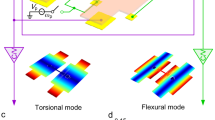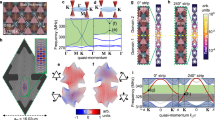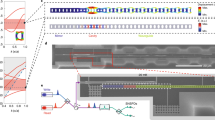Abstract
Mechanical resonators are important components of devices that range from gravitational wave detectors to cellular telephones. They serve as high-performance transducers, sensors and filters by offering low dissipation, tunable coupling to diverse physical systems, and compatibility with a wide range of frequencies, materials and fabrication processes. Systems of mechanical resonators typically obey reciprocity, which ensures that the phonon transmission coefficient between any two resonators is independent of the direction of transmission1,2. Reciprocity must be broken to realize devices (such as isolators and circulators) that provide one-way propagation of acoustic energy between resonators. Such devices are crucial for protecting active elements, mitigating noise and operating full-duplex transceivers. Until now, nonreciprocal phononic devices3,4,5,6,7,8,9,10,11 have not simultaneously combined the features necessary for robust operation: strong nonreciprocity, in situ tunability, compact integration and continuous operation. Furthermore, they have been applied only to coherent signals (rather than fluctuations or noise), and have been realized exclusively in travelling-wave systems (rather than resonators). Here we describe a scheme that uses the standard cavity-optomechanical interaction to produce robust nonreciprocal coupling between phononic resonators. This scheme provides about 30 decibels of isolation in continuous operation and can be tuned in situ simply via the phases of the drive tones applied to the cavity. In addition, by directly monitoring the dynamics of the resonators we show that this nonreciprocity can control thermal fluctuations, and that this control represents a way to cool phononic resonators.
This is a preview of subscription content, access via your institution
Access options
Access Nature and 54 other Nature Portfolio journals
Get Nature+, our best-value online-access subscription
$29.99 / 30 days
cancel any time
Subscribe to this journal
Receive 51 print issues and online access
$199.00 per year
only $3.90 per issue
Buy this article
- Purchase on Springer Link
- Instant access to full article PDF
Prices may be subject to local taxes which are calculated during checkout




Similar content being viewed by others
Data availability
The datasets generated during and/or analysed during the current study are available from the corresponding author on reasonable request.
References
Jalas, D. et al. What is—and what is not—an optical isolator. Nat. Photon. 7, 579–582 (2013).
Fleury, R., Sounas, D., Haberman, M. R. & Alù, A. Nonreciprocal acoustics. Acoust. Today 11, 14–21 (2015).
Lewis, M. F. & Patterson, E. Acoustic-surface-wave isolator. Appl. Phys. Lett. 20, 276–278 (1972).
Camley, R. E. Nonreciprocal surface waves. Surf. Sci. Rep. 7, 103–187 (1987).
Sasaki, R., Nii, Y., Iguchi, Y. & Onose, Y. Nonreciprocal propagation of surface acoustic wave in Ni/LiNbO3. Phys. Rev. B 95, 020407 (2017).
Liang, B., Guo, X. S., Tu, J., Zhang, D. & Cheng, J. C. An acoustic rectifier. Nat. Mater. 9, 989–992 (2010).
Boechler, N., Theocharis, G. & Daraio, C. Bifurcation-based acoustic switching and rectification. Nat. Mater. 10, 665–668 (2011).
Popa, B.-I. & Cummer, S. A. Non-reciprocal and highly nonlinear active acoustic metamaterials. Nat. Commun. 5, 3398 (2014).
Fleury, R., Sounas, D. L., Sieck, C. F., Haberman, M. R. & Alù, A. Sound isolation and giant linear nonreciprocity in a compact acoustic circulator. Science 343, 516–519 (2014).
Xu, H., Mason, D., Jiang, L. & Harris, J. G. E. Topological energy transfer in an optomechanical system with an exceptional point. Nature 537, 80–83 (2016).
Xu, H., Mason, D., Jiang, L. & Harris, J. G. E. Topological dynamics in an optomechanical system with highly non-degenerate modes. Preprint at https://arxiv.org/abs/1703.07374 (2017).
Ruesink, F., Miri, M.-A., Alù, A. & Verhagen, E. Nonreciprocity and magnetic-free isolation based on optomechanical interactions. Nat. Commun. 7, 13662 (2016).
Huang, P. et al. Nonreciprocal radio frequency transduction in a parametric mechanical artificial lattice. Phys. Rev. Lett. 117, 017701 (2016).
Sounas, D. L. & Alù, A. Non-reciprocal photonics based on time modulation. Nat. Photon. 11, 774–783 (2017).
Peterson, G. A. et al. Demonstration of efficient nonreciprocity in a microwave optomechanical circuit. Phys. Rev. X 7, 031001 (2017).
Bernier, N. R. et al. Nonreciprocal reconfigurable microwave optomechanical circuit. Nat. Commun. 8, 604 (2017).
Barzanjeh, S. et al. Mechanical on-chip microwave circulator. Nat. Commun. 8, 953 (2017).
Ruesink, F., Mathew, J. P., Miri, M.-A., Alù, A. & Verhagen, E. Optical circulation in a multimode optomechanical resonator. Nat. Commun. 9, 1798 (2018).
Aspelmeyer, M., Kippenberg, T. & Marquardt, F. Cavity optomechanics. Rev. Mod. Phys. 86, 1391–1452 (2014).
Zwickl, B. M. et al. High quality mechanical and optical properties of commercial silicon nitride membranes. Appl. Phys. Lett. 92, 103125 (2008).
Buchmann, L. F. & Stamper-Kurn, D. M. Nondegenerate multimode optomechanics. Phys. Rev. A 92, 013851 (2015).
Weaver, M. J. et al. Coherent optomechanical state transfer between disparate mechanical resonators. Nat. Commun. 8, 824 (2017).
Metelmann, A. & Clerk, A. A. Nonreciprocal photon transmission and amplification via reservoir engineering. Phys. Rev. X 5, 021025 (2015).
Ranzani, L. & Aumentado, J. Graph-based analysis of nonreciprocity in coupled-mode systems. New J. Phys. 17, 023024 (2015).
Fang, K. et al. Generalized non-reciprocity in an optomechanical circuit via synthetic magnetism and reservoir engineering. Nat. Phys. 13, 465–471 (2017).
Malz, D. et al. Quantum-limited directional amplifiers with optomechanics. Phys. Rev. Lett. 120, 023601 (2018).
Barzanjeh, S., Aquilina, M. & Xuereb, A. Manipulating the flow of thermal noise in quantum devices. Phys. Rev. Lett. 120, 060601 (2018).
Clerk, A. A., Devoret, M. H., Girvin, S. M., Marquardt, F. & Schoelkopf, R. J. Introduction to quantum noise, measurement, and amplification. Rev. Mod. Phys. 82, 1155–1208 (2010).
Yamamoto, K., Otsuka, S., Ando, M., Kawabe, K. & Tsubono, K. Experimental study of thermal noise caused by an inhomogeneously distributed loss. Phys. Lett. A 280, 289–296 (2001).
Schwarz, C. et al. Deviation from the normal mode expansion in a coupled graphene-nanomechanical system. Phys. Rev. Appl. 6, 064021 (2016).
Unterreithmeier, Q. P., Weig, E. M. & Kotthaus, J. P. Universal transduction scheme for nanomechanical systems based on dielectric forces. Nature 458, 1001–1004 (2009).
Teufel, J. D. et al. Circuit cavity electromechanics in the strong-coupling regime. Nature 471, 204–208 (2011).
Okamoto, H. et al. Coherent phonon manipulation in coupled mechanical resonators. Nat. Phys. 9, 480–484 (2013).
Shkarin, A. B. et al. Optically mediated hybridization between two mechanical modes. Phys. Rev. Lett. 112, 013602 (2014).
Acknowledgements
This work is supported by the Air Force Office of Scientific Research grant number FA9550-15-1-0270, the Air Force Office of Scientific Research Multidisciplinary University Research Initiative grant number FA9550-15-1-0029, the Office of Naval Research Multidisciplinary University Research Initiative grant number N00014-15-1-2761 and the Simons Foundation (award number 505450).
Reviewer information
Nature thanks Claudiu Genes, Andre Xuereb and the other anonymous reviewer(s) for their contribution to the peer review of this work.
Author information
Authors and Affiliations
Contributions
H.X., A.A.C. and J.G.E.H. designed the study. H.X. and L.J. carried out the measurements. H.X. and L.J. analysed the data. All authors contributed to the writing of the manuscript.
Corresponding author
Ethics declarations
Competing interests
The authors declare no competing interests.
Additional information
Publisher’s note: Springer Nature remains neutral with regard to jurisdictional claims in published maps and institutional affiliations.
Extended data figures and tables
Extended Data Fig. 1 Temperature of each phononic mode as a function of the control tone phase.
This data was used to calculate the normalized temperature ratio shown in Fig. 4b. The error bars show the standard error of the mean.
Rights and permissions
About this article
Cite this article
Xu, H., Jiang, L., Clerk, A.A. et al. Nonreciprocal control and cooling of phonon modes in an optomechanical system. Nature 568, 65–69 (2019). https://doi.org/10.1038/s41586-019-1061-2
Received:
Accepted:
Published:
Issue Date:
DOI: https://doi.org/10.1038/s41586-019-1061-2
This article is cited by
-
Higher-order singularities in phase-tracked electromechanical oscillators
Nature Communications (2023)
-
Coherent memory for microwave photons based on long-lived mechanical excitations
npj Quantum Information (2023)
-
Electrical control of surface acoustic waves
Nature Electronics (2022)
-
Non-Hermitian chiral phononics through optomechanically induced squeezing
Nature (2022)
-
Chiral and degenerate perfect absorption on exceptional surfaces
Nature Communications (2022)
Comments
By submitting a comment you agree to abide by our Terms and Community Guidelines. If you find something abusive or that does not comply with our terms or guidelines please flag it as inappropriate.



